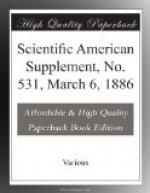NOTE.—In this experiment, part of the steam was dissociated in passing through the turned-up end of the steam supply pipe, which became very hot, and the steam would form with the iron the magnetic oxide (Fe_{3}O_{4}). The reduction would doubtless be due to this dissociation. The pieces of ore found on lowest end of the tube, A, were dark colored and semi-fused; part of one of these pieces was crushed fine, and tested; see column I. The remainder of these black pieces was mixed with the rest of the ore contained in tube, A, and ground and tested; see column II. The ore in upper tube was all broken up together and tested; see column III. When finely crushed, the color of No. I. was bluish black; No. II., a shade darker red; No. III., a little darker than the natural color of the ore. The analyses gave:
-----------------------------+---------+---------+-----
---- | I. | II. | III. +---------+---------+--------- |per cent.|per cent.|per cent. Ferric oxide (Fe_{2}O_{3}). | 68.55 | 76.47 | 84.81 Ferrous oxide (FeO). | 16.20 | 9.50 | 1.50 +---------+---------+--------- Total. | 84.75 | 85.97 | 86.31 +---------+---------+--------- Calculated: | | | Ferric oxide (Fe_{2}O_{3}). | 32.55 | 55.36 | 81.47 Magnetic oxide (Fe_{3}O_{4}).| 52.20 | 30.61 | 4.84 Ferrous oxide (FeO). | | | +---------+---------+--------- Total. | 84.75 | 85.97 | 86.31 +---------+---------+--------- Percentage of total oxygen reduced. | 6.93 | 4.02 | 1.07 Metallic iron. | 60.59 | 60.92 | 60.54 -----------------------------+---------+---------+---------<
/pre>Second Experiment, Water Gas.—The tube, A, was filled with small pieces of anthracite, and heated until all the volatile matter had been expelled. The tube, B, was then placed in tube, A, the joint being made with fireclay, and to prevent the steam from carrying small particles of solid carbon into ore in the upper tube, the anthracite was divided from the ore by means of a piece of fine wire gauze. The steam at a pressure of about 35 lb. to the square inch was passed through the anthracite. The tube, A, was heated to white heat, the tube, B, at its lower end to bright red, the top to cherry red.
------------------+-----+-----+-----+-----+-----+-----+
-----+-----+-----+-----+ Experiment. | 1st. | 2d. | 3d. | ------------------+-----+-----+-----+-----+-----+-----+-----
+-----+-----+-----+ Number. | I. | II. | III.| I. | II. | III.| IV. | I. | II. | III.| ------------------+-----+-----+-----+-----+-----+-----+-----
+-----+-----+-----+ Total Iron. |60.59|60.92|60.54|65.24|61.71|61.93|57.23
|59.73|57.93|55.54| ------------------+-----+-----+-----+-----+-----+-----+-----
+-----+-----+-----+Iron occurring as ------------------+-----+-----+-----+-----+-----+-----+-----
+-----+-----+-----+




